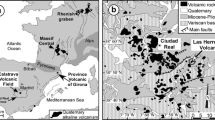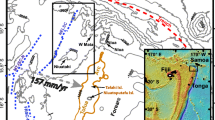Abstract
The 1986 eruption of B fissure at Izu-Oshima Volcano, Japan, produced, among other products, one andesite and two basaltic andesite lava flows. Locally the three flows resemble vent-effused holocrystalline blocky or aa lava; however, remnant clast outlines can be identified at most localities, indicating that the flows were spatter fed or clastogenic. The basaltic andesite flows are interpreted to have formed by two main processes: (a) reconstitution of fountain-generated spatter around vent areas by syn-depositional agglutination and coalescence, followed by extensional non-particulate flow, and (b) syn-eruptive collapse of a rapidly built spatter and scoria cone by rotational slip and extensional sliding. These processes produced two morphologically distinct lobes in both flows by: (a) earlier non-particulate flow of agglutinate and coalesced spatter, which formed a thin lobe of rubbly aa lava (ca. 5 m thick) with characteristic open extension cracks revealing a homogeneous, holocrystalline interior, and (b) later scoria-cone collapse, which created a larger lobe of irregular thickness (<20 m) made of large detached blocks of scoria cone interpreted to have been rafted along on a flow of coalesced spatter. The source regions of these lava flows are characterized by horseshoe-shaped scarps (<30 m high), with meso-blocks (ca. 30 m in diameter) of bedded scoria at the base. One lava flow has a secondary lateral collapse zone with lower (ca. 7 m) scarps. Backward-tilted meso-blocks are interpreted to be the product of rotational slip, and forward-tilted blocks the result of simple toppling. Squeeze-ups of coalesced spatter along the leading edge of the meso-blocks indicate that coalescence occurred in the basal part of the scoria cone. This low-viscosity, coalesced spatter acted as a lubricating layer along which basal failure of the scoria cone occurred. Rotational sliding gave way to extensional translational sliding as the slide mass spread out onto the present caldera floor. Squeeze-ups concentrated at the distal margin indicate that the extensional regime changed to one of compression, probably as a result of cooling of the flow front. Sliding material piled up behind the slowing flow front, and coalesced spatter was squeezed up from the interior of the flow through fractures and between rafted blocks. The andesite flow, although morphologically similar to the other two flows, has a slightly different chemical composition which corresponds to the earliest stage of the eruption. It is a much smaller lava flow emitted from the base of the scoria cone 2 days after the eruption had ceased. This lava is interpreted to have been formed by post-depositional coalescence of spatter under the influence of the in-situ cooling rate and load pressure of the deposit. Extrusion occurred through the lower part of the scoria cone, and subsequent non-particulate flow of coalesced material produced a blocky and aa lava flow. The mechanisms of formation of the lava flows described may be more common during explosive eruptions of mafic magma than previously envisaged.
Similar content being viewed by others
Author information
Authors and Affiliations
Additional information
Received: 30 May 1997 / Accepted: 19 May 1998
Rights and permissions
About this article
Cite this article
Sumner, J. Formation of clastogenic lava flows during fissure eruption and scoria cone collapse: the 1986 eruption of Izu-Oshima Volcano, eastern Japan. Bull Volcanol 60, 195–212 (1998). https://doi.org/10.1007/s004450050227
Issue Date:
DOI: https://doi.org/10.1007/s004450050227




